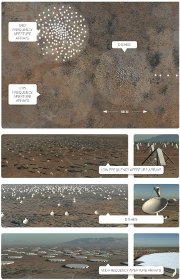What is SKA?
The Square Kilometre Array (SKA) will be a multi-purpose interferometer of thousands of antennas linked together to provide a collecting area of one square kilometre and distributed in an area nearly the size of a continent. The SKA will be 50 times more sensitive than any other radio instrument and will survey the sky at least 10.000 times faster than the best current-day telescopes. Signals from separated antennas shall be combined via high-speed data links to a central processor, providing an angular resolution equivalent to that of a telescope with a diameter of more than 3000 km.

In order to achieve both high sensitivity and high-resolution images of the radio sky, the antennas of the SKA will be densely distributed in the central region of the array, and then logarithmically positioned in groups (more spaced at extremes) along several spiral arms extending up to 3000 km from the central core.

Three antenna types, high frequency dishes and mid & low-frequency aperture arrays, will be used to provide continuous frequency coverage from 70 MHz to 10 GHz.
In the lower (70-450 MHz) and middle (450-1400 MHz) part of the frequency band, two different types of antenna, aperture arrays, will act as a radio wide-angle lens and will be used to observe very large areas of the sky simultaneously. In the higher (1.2-10 GHz) part of the frequency band, the SKA will use 3000 dish antennas, each about 15 m wide, which will operate as a radio camera to provide high quality images.
The signal from the receiving elements will be transported back by optical fibres carrying up to 420 Gb/sec per dish and 16 Tb/sec per aperture array to a central processing engine where the data will be handling to form images and time series, and to combat the effect of radio frequency interference (RFI) signals.
A summary of the main SKA parameters is shown below.
| Frequency Range | 70 MHz To 10 GHz |
| Sensitivity Area / System Temp | 5000 m²/K (400 µjy in 1 minute) between 70 And 300 MHz |
| Survey Figure-Of-Merit | 4×107 – 2×1010 m4k-2 deg2 depending on sensor technology and frequency |
| Field-Of-View | 200 square degrees between 70 And 300 MHz 1-200 square degrees between 0.3 And 1 GHz 1 square degree maximum between 1 And 10 GHz |
| Angular Resolution | <0.1 arcsecond |
| Instantaneous Bandwidth | Band Centre ± 50%s |
| Spectral (Frequency) Channels | 16384 per band per baseline |
| Calibrated Polarisation Purity | 10000:1 |
| Synthesised Image Dynamic Range | <1000000 |
| Imaging Processor Computation | 10~17 operations/second |
| Final Processed Data Output | 10 Gb/second |
Two locations were under consideration: Southern Africa and Australia–New Zealand. Finally, on May 2012, the Members of the SKA Organisation agreed on a dual site solution for the Square Kilometre Array telescope. The ASKAP and MeerKAT precursor dishes will be incorporated into Phase I of the SKA to maximise on investments already made by both Australia and South Africa.
The total target cost for SKA is 1500 M€. The SKA project shall be implemented in phases, which is an effective strategy for an aperture synthesis telescope which can start operating before construction is complete. SKA1 the initial deployment (10%) of the array at low and mid-band frequencies costing 350 M€ (in 2007 currency units).
